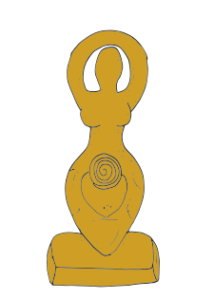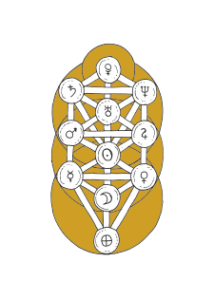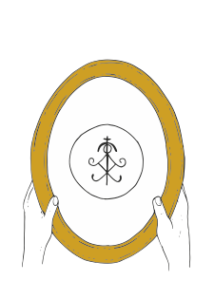An Introduction to Chaos Magic: Exclusive Excerpt from How to Study Magic

Practicing witch Sarah Lyons, author of Revolutionary Witchcraft, is often asked “How do you start doing this stuff?” Her answer in full is her forthcoming illustrated book, How to Study Magic: A Guide to History, Lore, and Building Your Own Practice.
This unique introduction to the world of magic lays out the history and lore of the five paths most often encountered in modern magic, plus activities to help you craft your own personalized rituals and recommendations for further reading to deepen your practice.
RP Mystic’s exclusive excerpt features an introduction to one of those paths, Chaos Magic, plus step-by-step instructions on making a servitor! How to Study Magic is on sale now.
Chaos Magic
Let’s get something cleared up right off the bat: I’m calling it magic, not magik, magick, or majick. This book isn’t being written in the 1990s.
Now that we have that out of the way, let’s introduce chaos magic (and why some people spell it with a k).
While the rest of this book is laid out more or less chronologically, we’re going to start with the youngest form of magic we’ll be looking at. Chaos magic is a postmodern form of magic—with most of its foundational texts having been written in the last few decades and ideas and language that are fairly modern. Because of this, I find it easiest to explain what magic is to newbies using chaos magic, even if it’s not the form of magic they ultimately want to stick with.
 Let’s face it, even if we’ve had magical experiences, or seen a ghost, or want to believe, we live in a world that is fundamentally unmagical. In chaos magic this is called consensus reality, which refers to the dominant views about the nature of what is “real” that a culture or group of people has. Ideas about gender, sexuality, money, values, and politics almost all fall under the idea of consensus reality. Another example of a consensus reality is citizenship: whether you are a citizen of this place or that place depends on which side of an imaginary line you were born, and that line only really exists because we all believe it does. It takes years of what’s called deconditioning through ritual and reshaping your thoughts to break from consensus reality and begin to take a bit of your destiny into your own hands, magically speaking. The language and philosophy of chaos magic, in my experience, help you do this and are designed to make magic accessible.
Let’s face it, even if we’ve had magical experiences, or seen a ghost, or want to believe, we live in a world that is fundamentally unmagical. In chaos magic this is called consensus reality, which refers to the dominant views about the nature of what is “real” that a culture or group of people has. Ideas about gender, sexuality, money, values, and politics almost all fall under the idea of consensus reality. Another example of a consensus reality is citizenship: whether you are a citizen of this place or that place depends on which side of an imaginary line you were born, and that line only really exists because we all believe it does. It takes years of what’s called deconditioning through ritual and reshaping your thoughts to break from consensus reality and begin to take a bit of your destiny into your own hands, magically speaking. The language and philosophy of chaos magic, in my experience, help you do this and are designed to make magic accessible.
Emerging in the UK in the 1970s alongside the punk movement, chaos magic took a radical approach to the occult that was somewhat controversial at the time. Chaos magicians weren’t concerned with fancy robes, ancient orders, or climbing levels of initiation. Instead, they said that anyone can do magic—in fact, we all do it all the time—and that the actual “tech” of doing magic is basically the same all over the world, just in different costumes. Whether you agree with this last part or not, I commend chaos magic for breaking down the door of the temple and letting regular people inside.
Chaos magic isn’t religious, and it isn’t particularly concerned with morality. It’s about breaking magic down into a technology, in the process figuring out what makes magic work and discarding everything that doesn’t. It’s an eclectic practice, in which gods are given the same level of importance as rock stars, pop culture figures, and fictional characters, and reality is seen as a field of overlapping belief systems. Navigating this landscape of the mind is where chaos magic thrives.
 In this chapter, we’re going to look at the core principles, ideas, and history of chaos magic. My hope is that these ideas will help make magic real to you and that you keep them in mind as we proceed through the rest of this book. As we go, we’ll be covering some weird topics and difficult concepts that trip a lot of people up. My hope is that understanding the principles of chaos magic will make grasping and practicing other forms of magic easier for you.
In this chapter, we’re going to look at the core principles, ideas, and history of chaos magic. My hope is that these ideas will help make magic real to you and that you keep them in mind as we proceed through the rest of this book. As we go, we’ll be covering some weird topics and difficult concepts that trip a lot of people up. My hope is that understanding the principles of chaos magic will make grasping and practicing other forms of magic easier for you.
Chaos in a Nutshell
Chaos magic is highly individualized and shirks dogma of all kinds, so it can be hard to pin down what chaos magic is in totality. Some basic principles Phil Hine outlines in his outstanding book Condensed Chaos help us get to the heart of chaos:
No Dogma
Chaos magicians reject dogma, strict ideas, or any assumption that rules need to be followed. The only exception might be if strict adherence to rules helps you achieve a magical goal.
A Reliance on Personal Experience
You must actually do magic to get good at it. How you do magic, and which exercises you practice, might not look like what other people are doing, but a certain level of discipline is required to get good at anything—and magic is no exception. Additionally, if something works for you that people say “shouldn’t” or is impossible, pay them no mind and do your own thing.
Decondition Yourself
As I mentioned before, we’re born into a world that throws all sorts of ideas at us about who we are and what we should do with our lives. You need to break away from these ideas to see which ones serve you, which ones don’t, and ultimately become less attached to ideas and dogma in general.
Diverse Approaches
Everyone is different, and what works for one person might not work for another. The goal isn’t to force someone to do magic your way or to force yourself into what you think you “should” be doing. Instead, your goal is, through trial and error, to figure out what works for you.
Gnosis
This word is used differently in chaos magic than in other forms of magic we’ll cover later. For chaos magicians, gnosis is the ability to shift your consciousness at will. We all shift our consciousness when we sleep, drink alcohol, or zone out on long drives, but doing this at will helps you get into a magical state of mind.
It’s All About Results
 Chaos magic came about during a time when the occult scene in the UK was dominated by Wicca, Thelema, and remnants of the Golden Dawn and nineteenth-century occultism. These religions and groups, as we’ll learn in later chapters, often had very specific ideas about what magic is and how to do it. Things like ceremonial magic (see chapter 5) have elaborate rituals for just about everything— from making a wand to picking that wand up to using that wand to putting it back down—and, no, I’m not exaggerating. People at the time believed, and many still do, that if you didn’t do all these rituals perfectly and weren’t initiated into the right magical orders, then magic simply wouldn’t work for you.
Chaos magic came about during a time when the occult scene in the UK was dominated by Wicca, Thelema, and remnants of the Golden Dawn and nineteenth-century occultism. These religions and groups, as we’ll learn in later chapters, often had very specific ideas about what magic is and how to do it. Things like ceremonial magic (see chapter 5) have elaborate rituals for just about everything— from making a wand to picking that wand up to using that wand to putting it back down—and, no, I’m not exaggerating. People at the time believed, and many still do, that if you didn’t do all these rituals perfectly and weren’t initiated into the right magical orders, then magic simply wouldn’t work for you.
As a reaction against this, people started taking a DIY approach, grounded in the idea that magic is something anyone can do. Chaos magic is a very personal and customizable practice, as opposed to a cookie-cutter one. Through studying chaos magic, you’re in many ways studying yourself. Maybe you get better results from a spell by following the formula to a T, or maybe it works just as well if you substitute in new ingredients, chants, gestures, and so forth. One reason why keeping a magical journal is important is so you can track these results and see what works for you.
Activity: Making a Servitor
So what is a servitor? Well, it’s basically an inspirited sigil or thoughtform—one that you give a name and maybe even a personality. You’ll have a more hands-on relationship with a servitor than you would with a normal sigil. While sigils might be good for specific, unusual problems, servitors are good for long-term help. You’re essentially making a little spirit, familiar, or mental computer program—depending on your magical model—that can handle tasks and work for you on specific requests. You’ll feed this servitor by creating a sigil and making a small altar or space for it to “live,” where you can leave offerings when it comes through for you.
For example, let’s say you drive for a living and have a hard time finding parking in the city or town where you reside. You could create a sigil out of the phrase “I am always able to find parking,” if you like you can give it a name (literally something as simple as “Heck yes” so you can easily and covertly thank it when you find parking), and set up a little altar in your car or garage. You can already see how this is a little less intimidating than summoning an ancient demon to find you parking.
For this activity, you will need:
Paper
A pen or marker
A glass of water
Other art supplies like glitter, glue, images from magazines or the internet, etc. (optional)
Making a servitor has several steps. The first is crafting a sigil, so let’s go over that process quickly.
Figure out a statement of intent, or something you want the servitor to do. Keep it simple, present tense, and positive, like “gigs come easily to me” or “lots of great people want to date me.” Remember, you can always make others down the line to add specificity.
- Take out all the vowels and repeating letters.
- Arrange the remaining letters into a symbol.
- Make the symbol look cool by drawing it in the colors and style you think suit it.
 Now, keep in mind that while a normal sigil is great for one-off problems, like finding a new apartment, servitors are better for tasks you’ll need help with on a regular basis. Once you have your sigil, feel free to make it as artistic and crazy as you want. There really are no rules here, and in fact I think it’s best to let your imagination go wild, whether that’s making a collage, a painting, macaroni art, or whatever else your heart desires.
Now, keep in mind that while a normal sigil is great for one-off problems, like finding a new apartment, servitors are better for tasks you’ll need help with on a regular basis. Once you have your sigil, feel free to make it as artistic and crazy as you want. There really are no rules here, and in fact I think it’s best to let your imagination go wild, whether that’s making a collage, a painting, macaroni art, or whatever else your heart desires.
After you have your sigil, the next step is charging it. I like the word charging because it has two magical meanings. In one sense, you are imbuing an object with energy or power, like charging a battery. In another sense, you are giving this object a charge, or duty, to perform.
There are lots of ways to charge a sigil—or any object for that matter. Dancing around it, singing to it, burning incense, or any number of creative things all work to charge sigils, if they work for you. For now, I’m going to share a simple technique that I’ve found works well for most beginners.
- Sit comfortably and allow yourself to take several deep, calming breaths.
- Hold the sigil in your hands.
- Close your eyes and imagine a warm light coming up from the very core of the earth. It slowly travels up your spinal cord until it rests in the center of your chest.
- Now, imagine another light that descends from above and travels down your spine to meet the first beam of light.
- Your body fills with light, and you slowly start to push that light out of your body into the sigil.
- Once you feel your sigil is properly charged, open your eyes and hold it up to you.
- Give it instructions for what its purpose will be, perhaps even just restating your goal or desire.

The final, and longest, step will be setting up an altar for this servitor to live on and deciding what kind of offerings to leave it. This doesn’t have to be complicated—I recommend just a glass of water and maybe a candle or two when you are first getting started. Let this servitor know what the deal is: that you’ll leave it a glass of water once a week and better offerings when it delivers on its mission statement.
If the time comes when you no longer need this servitor, then it’s more than okay to let it go. In fact, it would be kind of rude to just forget about it. Thank it for the work it has done for you and leave it a final offering. Then, you can bury it at a crossroads, burn it, or dispose of it in a way you think is fitting for the task.
Have you ever wanted to dive into the world of magic, but weren’t sure where to begin? You’re not alone! Knowing where to start can be mystifying, but it doesn’t have to be. In How to Study Magic, author, educator, and seasoned witch Sarah Lyons guides you through an introductory course of study, and an enchanted entry point to the wide world of magical paths.
Drawing on Sarah’s own experience practicing and teaching magic for more than a decade, this interactive exploration takes novice witches through basic tools they can use in their studies—from divination and meditation to cleansing and protection—before diving into the history, lore, and modern incarnations of a wide range of magical practices. With chapters on Witchcraft, Chaos Magic, Spellbooks and Grimoires, Gods and Goddesses, and more, this dynamic guide gives readers an insider’s perspective on how to craft their own, personalized practice. Each chapter also contains interactive activities, journal prompts, and suggestions for further reading, allowing baby witches to chart their own paths and explore their own power.
For anyone who knows they want to study magic, but has no idea where to begin, How to Study Magic is the answer you’ve been waiting for.







